Knowing the signs of a heart attack and acting fast can save lives. Heart attacks are a leading cause of death in the U.S. This guide will teach you how to spot the signs, help someone in an emergency, and keep your heart healthy.
Key Takeaways
- Learn the common signs of a heart attack, like chest pain, shortness of breath, and cold sweats.
- Know how to do CPR and use an AED if someone is having a heart attack.
- Find out what increases your risk of a heart attack, such as high cholesterol and not being active. Work on reducing these risks.
- Know that getting medical help right away is crucial if you or someone else is having a heart attack.
- Keep up with new heart health tips and emergency response methods to be ready to help someone in need.
Recognizing the Warning Signs of a Heart Attack
Knowing the warning signs of a heart attack can save lives. Two key symptoms are chest pain or discomfort and shortness of breath.
Chest Pain and Discomfort
Chest pain is a common sign of a heart attack. It feels like a crushing or squeezing sensation in the chest. This sensation can spread to the arms, back, neck, or jaw.
The pain may come and go or stay constant. It might feel like tightness, pressure, or a dull ache.
Shortness of Breath
Feeling short of breath is another warning sign. This symptom can happen with or without chest pain. It feels like you’re having trouble breathing or not getting enough air.
It’s important to know these symptoms and act fast if you notice them. Quick action can greatly improve your chances of survival and recovery.
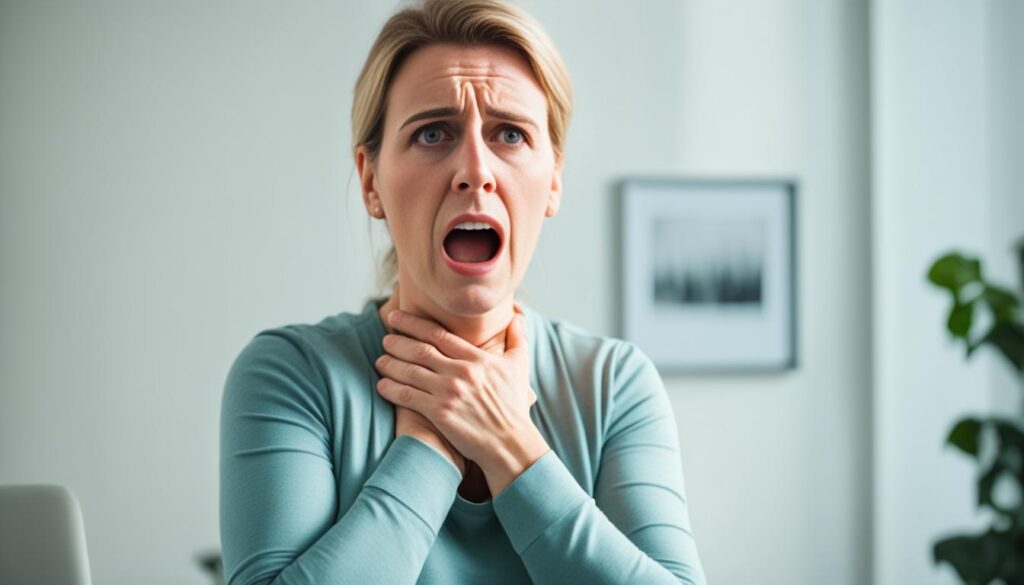
“Recognizing the warning signs of a heart attack and seeking prompt medical care can be the difference between life and death.”
Other Potential Heart Attack Symptoms
Chest pain and shortness of breath are the top signs of a heart attack. But, there are other symptoms that are just as important. Knowing these signs can help you get medical help fast and save lives.
Arm, Neck, or Jaw Pain
Many people feel pain or discomfort in their arms, neck, or jaw during a heart attack. This pain can feel like a dull ache, a sharp pain, or a tight feeling. It often starts in the chest and spreads to these areas. Always take this pain seriously, even if you don’t have chest pain.
Cold Sweats and Nausea
Heart attack symptoms like cold sweats and nausea are easy to miss. If you’re having a heart attack, you might feel cold and sweaty, even if it’s not hot in the room. You might also feel sick, throw up, or have a general feeling of nausea. Sometimes, you won’t have any chest pain at all.
Noticing these signs can help you act fast if you’re having a heart attack. Quick action can save your life and protect your heart from damage.
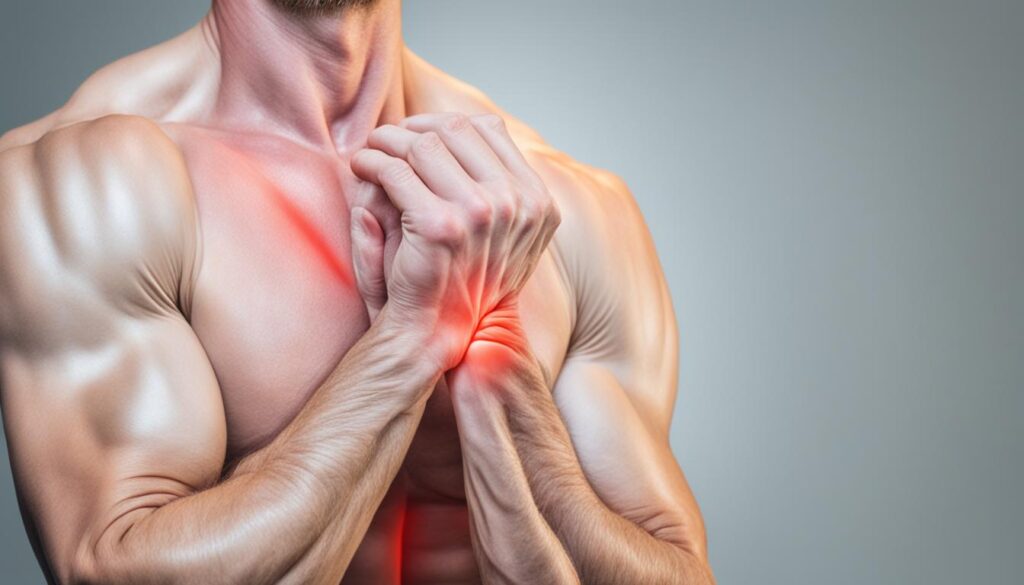
| Symptom | Description |
|---|---|
| Arm, Neck, or Jaw Pain | Dull ache, sharp pain, or feeling of tightness/pressure in the arms, neck, or jaw |
| Cold Sweats and Nausea | Sudden onset of clammy, cold sweats and feelings of nausea or sickness |
“Recognizing the less obvious signs of a heart attack can be the difference between life and death. Don’t hesitate to seek medical attention if you experience any unusual symptoms, even if they don’t fit the classic description.”
heart attack signs, heart health, emergency response, cardiac arrest, CPR
Knowing the signs of a heart attack can save lives. We must learn the symptoms to act fast. Symptoms like chest pain and shortness of breath need quick action.
When you think someone is having a heart attack, act fast. CPR can keep the heart and brain supplied with oxygen until help comes. Learning CPR can be a lifesaver.
Keeping your heart healthy can prevent heart attacks. Eating right, exercising, and managing health conditions help. These steps make your heart stronger.
Everyone should know how to spot and react to heart attack signs. It’s key for both doctors and everyday people. Being ready to help can change lives.

“Recognizing the warning signs of a heart attack and knowing how to respond can mean the difference between life and death.”
Differentiating Heart Attack from Other Conditions
Feeling chest pain or discomfort can be scary, and it’s hard to know if it’s a heart attack or not. Heart attack symptoms can be similar to other health issues, like indigestion or anxiety. It’s important to know the differences to get the right treatment fast.
Heart attack pain feels tight, crushing, or heavy. Other issues like indigestion cause a burning or gnawing feeling. Heart attack pain can spread to the arms, neck, or jaw, but indigestion stays in the chest or upper belly.
Feeling short of breath is a common sign of a heart attack, along with cold sweats and nausea. But anxiety makes you breathe fast and shallow, not like you can’t breathe at all.
| Symptom | Heart Attack | Indigestion | Anxiety |
|---|---|---|---|
| Chest Pain | Tight, crushing, or heavy | Burning or gnawing | Varies |
| Pain Radiation | Arms, neck, or jaw | Localized to chest or upper abdomen | Varies |
| Shortness of Breath | Yes, often accompanied by cold sweats and nausea | No | Rapid, shallow breathing |
If you have these symptoms, it might not mean you’re having a heart attack. Always get medical help if you’re unsure. Knowing the differences can help you make quick decisions and save your life.
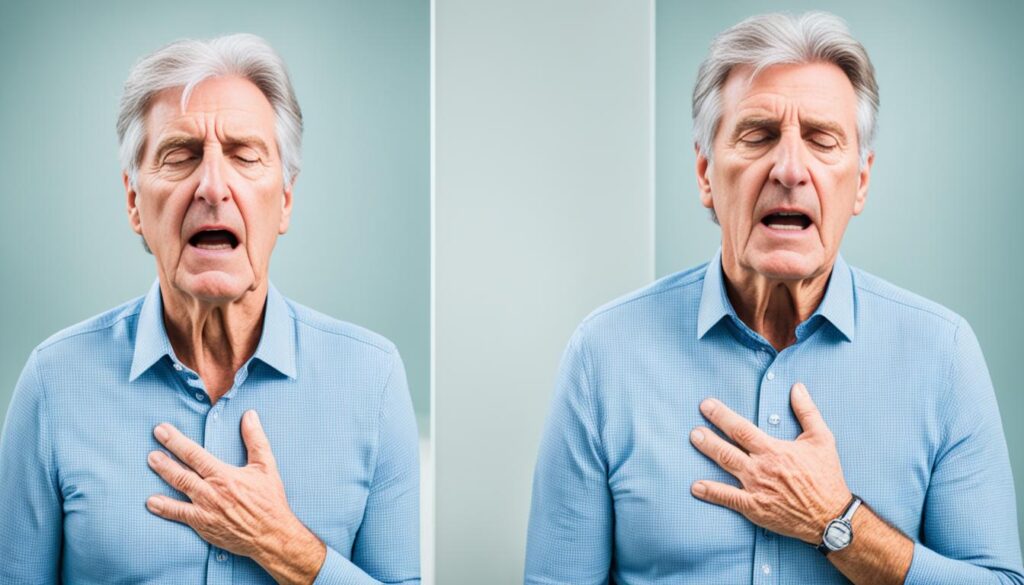
Immediate Actions: Call 911 and Begin CPR
If someone might be having a heart attack, act fast. First, call 911 for help. Then, start doing CPR (cardiopulmonary resuscitation). Check if the person is awake and breathing. If not, start doing chest compressions to keep blood flowing until help gets there.
Assessing Responsiveness and Breathing
First, gently shake the person’s shoulders and ask, “Are you okay?” If they don’t answer, see if they’re breathing right. Put your ear near their mouth and nose to check for breaths. If they’re not awake and not breathing right, they might be having a cardiac arrest.
Performing Chest Compressions
After checking and finding the person is not awake and not breathing, start chest compressions. Put one hand on the center of their chest and the other on top. Press down hard and fast, letting the chest go back up between presses. Try to do 100 to 120 compressions a minute. Keep going until help arrives or the person wakes up.
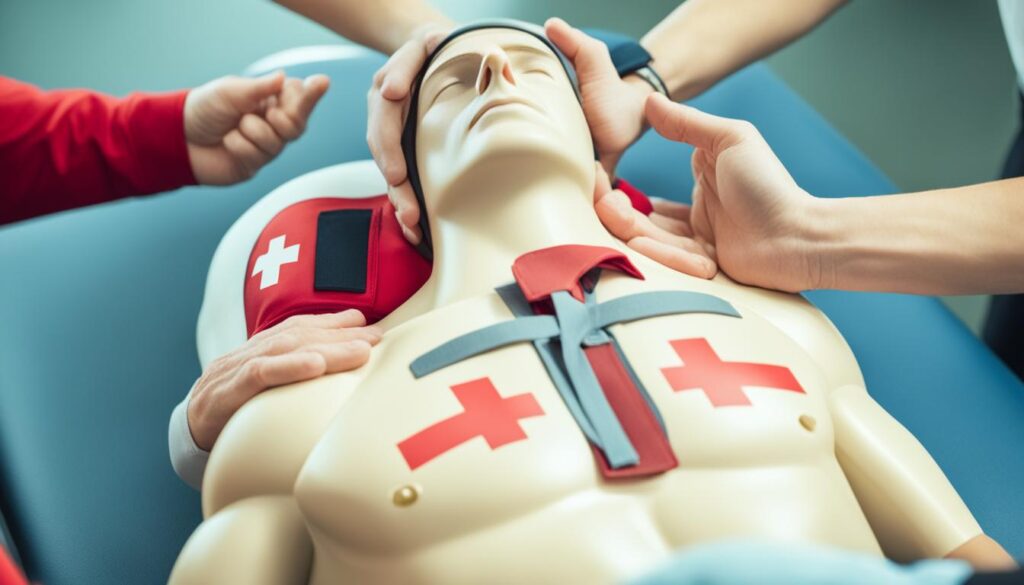
“Time is of the essence when it comes to a heart attack. The sooner you can call 911 and start CPR, the better the chances of survival.”
Importance of Acting Quickly
When a heart attack happens, every second matters. Recognizing the signs and acting fast, like doing CPR, can save lives. Prompt action can be the difference between life and death.
Studies prove that acting fast during a heart attack boosts survival chances. The first few minutes are key. The heart can’t pump blood well, so quick action is vital. It helps restore blood flow and oxygen, which could save a life.
- Look for warning signs like chest pain, shortness of breath, and cold sweats.
- Call 911 right away if you think someone is having a heart attack.
- Start CPR if the person isn’t awake and not breathing.
- Use an automated external defibrillator (AED) if it’s nearby.
By acting quickly and doing the right thing, you can greatly improve the chance of survival. Remember, every second is crucial. So, be ready to act fast if you think someone is having a heart attack.

“Time is muscle. The sooner you can restore blood flow, the less heart damage will occur.”
Risk Factors for Heart Attacks
Knowing the risk factors for heart attacks is key to protecting your heart health. These risks fall into two main groups: lifestyle and medical conditions.
Lifestyle Factors
Some lifestyle choices can raise your risk of a heart attack. These include:
- Poor diet, high in saturated and trans fats, cholesterol, and salt
- Lack of regular physical activity and exercise
- Excessive alcohol consumption
- Smoking or using other tobacco products
- Stress and poor coping mechanisms
Medical Conditions
Some medical conditions also increase your risk of a heart attack. These include:
- High blood pressure (hypertension)
- High cholesterol (hyperlipidemia)
- Type 2 diabetes
- Obesity
- Family history of heart disease
Knowing these risk factors helps you lower your heart attack risk. Regular health check-ups and healthier lifestyle factors can help manage these medical conditions.
Preventing Heart Attacks: Lifestyle Changes
Keeping a healthy lifestyle is key for your heart and lowering heart attack risk. Eating a low-cholesterol diet and exercising regularly are two main ways to keep your heart healthy.
Low Cholesterol Diet
Eating a low-cholesterol diet is great for your heart. Eat whole, unprocessed foods like fruits, veggies, whole grains, and lean proteins. Try to eat less saturated and trans fats as they can raise cholesterol and harm your arteries.
- Prioritize fruits, vegetables, and whole grains
- Choose lean proteins like chicken, fish, and legumes
- Limit consumption of red meat, dairy products, and fried foods
- Opt for healthy fats like olive oil, avocados, and nuts
Regular Exercise Routine
Staying active is vital for a healthy heart. Aim for at least 30 minutes of moderate-intensity exercise each day. You can walk briskly, swim, cycle, or dance. Adding strength training a few times a week can also make your heart stronger and boost your fitness.
| Exercise Type | Benefits for Heart Health |
|---|---|
| Aerobic Exercise | Improves circulation, lowers blood pressure, and reduces the risk of heart disease |
| Strength Training | Builds muscle, boosts metabolism, and enhances cardiovascular function |
By eating a low-cholesterol diet and exercising often, you can help keep your heart healthy and lower your heart attack risk. Remember, even small changes can greatly improve your heart health.

When to Seek Medical Attention
It’s very important to watch your heart health closely. Catching problems early and getting quick medical help can really help. If you notice symptoms like chest pain, shortness of breath, or other signs of a heart attack, act fast.
Don’t wait to call your doctor or 911 if you’re worried about your heart. Quick action is key in heart emergencies. The faster you get medical care, the less damage there will be and the better your chances of saving your life.
Here are some signs that mean you should get medical attention right away:
- Persistent or getting worse chest pain or discomfort
- Shortness of breath, especially when you’re resting or doing little activity
- Sudden and unexplained dizziness, feeling lightheaded, or fainting
- Irregular or fast heartbeat
- Severe and ongoing nausea or vomiting
If you see any of these signs, don’t wait. Get medical help right away to check and treat your heart health. Your life could depend on it.
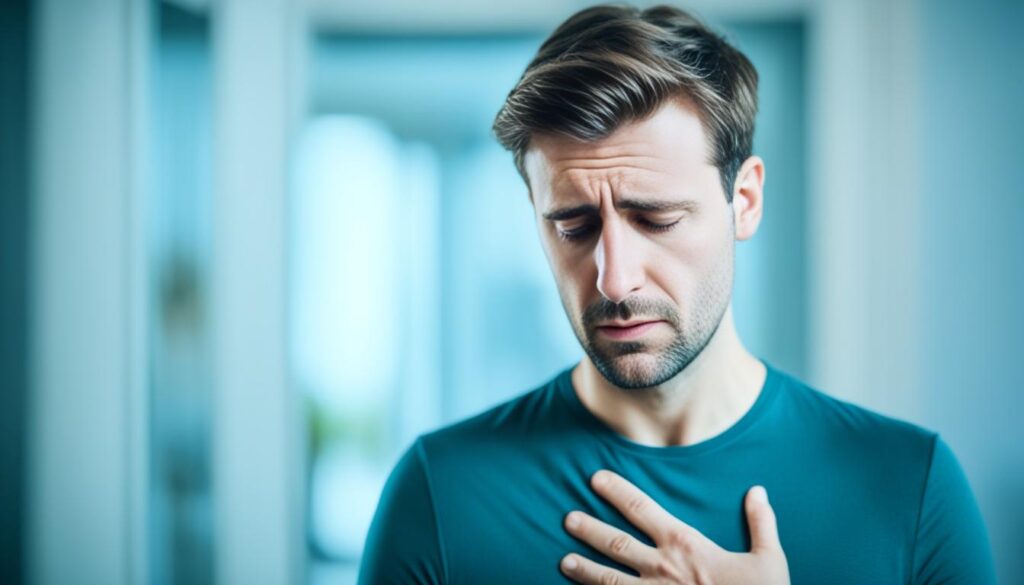
“Recognizing the signs of a heart attack and seeking prompt medical care can make the difference between life and death.”
Using an Automated External Defibrillator (AED)
If someone has a sudden cardiac arrest, using an automated external defibrillator (AED) can save their life. AEDs are easy to use. They give clear instructions and voice prompts to help you give electric shocks to the heart.
When someone collapses and won’t wake up, act fast. Call 911 and start doing chest compressions. If you have an AED, turn it on and listen to the instructions. The AED will check the heart rhythm and decide if a shock is needed.
- Make sure the area is safe and the person is on a flat surface.
- Turn on the AED and follow the voice prompts.
- Put the person’s bare chest bare and attach the adhesive pads as told.
- The AED will check the heart rhythm and see if a shock is needed.
- If a shock is advised, make sure everyone is away from the person, then press the shock button.
- Keep doing chest compressions and rescue breaths until help arrives.
Using an AED can greatly increase the chance of survival for someone having cardiac arrest. Knowing how to use an AED means you can act fast and effectively in an emergency.
| AED Manufacturer | Model | Battery Life | Shock Delivery |
|---|---|---|---|
| Philips | HeartStart FRx | 4 years | Up to 200 shocks |
| Zoll | AED Plus | 5 years | Up to 300 shocks |
| Physio-Control | LIFEPAK CR2 | 4 years | Up to 400 shocks |
Having an AED and knowing how to use it can really help someone having a cardiac arrest. Learn where AEDs are in your area and be ready to act fast if needed.
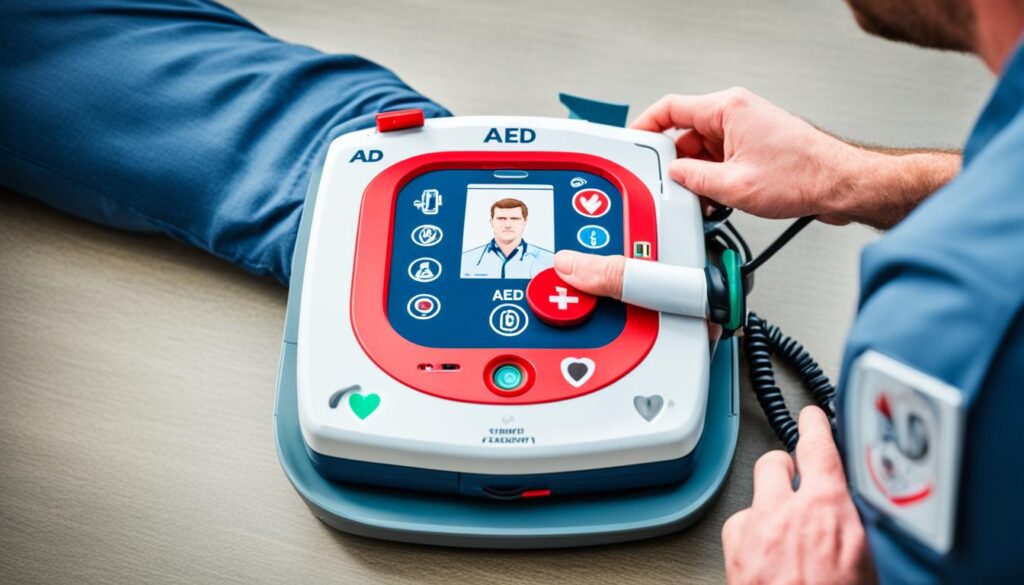
Post-Heart Attack Care and Recovery
Recovering from a heart attack is a critical time. It needs careful medical care and a solid rehabilitation plan. Patients must work closely with their healthcare team. This helps the heart heal and prevents future problems.
The care plan includes medication, cardiac rehab, and changing your lifestyle. Medicines like antiplatelet drugs, beta-blockers, and statins help manage conditions. They also lower the risk of another heart attack and boost heart health.
Cardiac rehabilitation programs are key for post-heart attack recovery. These programs offer supervised exercises and education. They help patients get stronger, improve their heart health, and make better lifestyle choices.
Key Elements of Post-Heart Attack Care
- Medically prescribed medications to manage risk factors
- Participation in a comprehensive cardiac rehabilitation program
- Adoption of a heart-healthy diet low in saturated fat and cholesterol
- Regular physical activity, as recommended by healthcare providers
- Stress management techniques to support emotional well-being
By listening to their healthcare team and taking an active role in their recovery, patients can boost their chances of a successful recovery. This includes following a post-heart attack care plan.
| Medication | Purpose |
|---|---|
| Antiplatelet drugs (e.g., aspirin, clopidogrel) | Reduce the risk of blood clots and another heart attack |
| Beta-blockers | Lower blood pressure and heart rate, improving heart function |
| Statins | Lower cholesterol levels to reduce the risk of heart disease |
“Comprehensive post-heart attack care and a dedicated recovery plan are essential for regaining strength, reducing the risk of future events, and achieving the best possible long-term outcome.”
Raising Awareness and Promoting Heart Health
Heart health awareness is key in our communities. By sharing info on heart attack signs and the need for quick action, we help people act fast. This can save lives and improve heart health in our areas.
We all can make a difference. By teaching ourselves and others, we become heart health advocates. Sharing info, planning events, or just talking about heart health helps. Every action we take can lead to a healthier future.
Empowering Through Education
Learning is the first step to action. We can give our communities the tools to act by sharing clear info on heart attack signs and what to do next. This can be done through health clinics, community centers, or social media.
- Make educational materials that show early heart attack signs
- Host workshops to teach CPR and how to use AEDs
- Use online platforms to share heart health tips and talk about it
Fostering a Heart-Healthy Culture
We can make heart health a big deal in our communities. By pushing for healthy living, backing local projects, and fighting for better healthcare, we help people take care of their hearts.
| Initiative | Impact |
|---|---|
| Community-based fitness programs | Encourage regular exercise and physical activity |
| Partnerships with healthcare providers | Help get preventive screenings and early care |
| Workplace wellness initiatives | Push for healthy habits and balance in work and life |
Together, we can build a strong base of heart health awareness. This lets people take steps towards better heart health.
“Healthy hearts are the lifeblood of our communities. Let’s work together to keep them strong and vibrant.”
Conclusion
This guide has shown us how crucial it is to know the signs of a heart attack and act fast. By learning about symptoms like chest pain, shortness of breath, and arm or jaw pain, we can spot a cardiac emergency. This knowledge helps us take the right steps to help someone in trouble.
It’s also key to know what to do if someone has a heart attack. Call 911, start CPR if you can, and use an AED if it’s there. These actions can greatly increase the chance of survival and lessen the heart attack’s effects.
Understanding heart health is about being aware, preventing problems, and acting fast in emergencies. By making healthy choices, managing health conditions, and watching for heart signs, we can all help fight heart attacks. This approach supports better heart health in our communities.

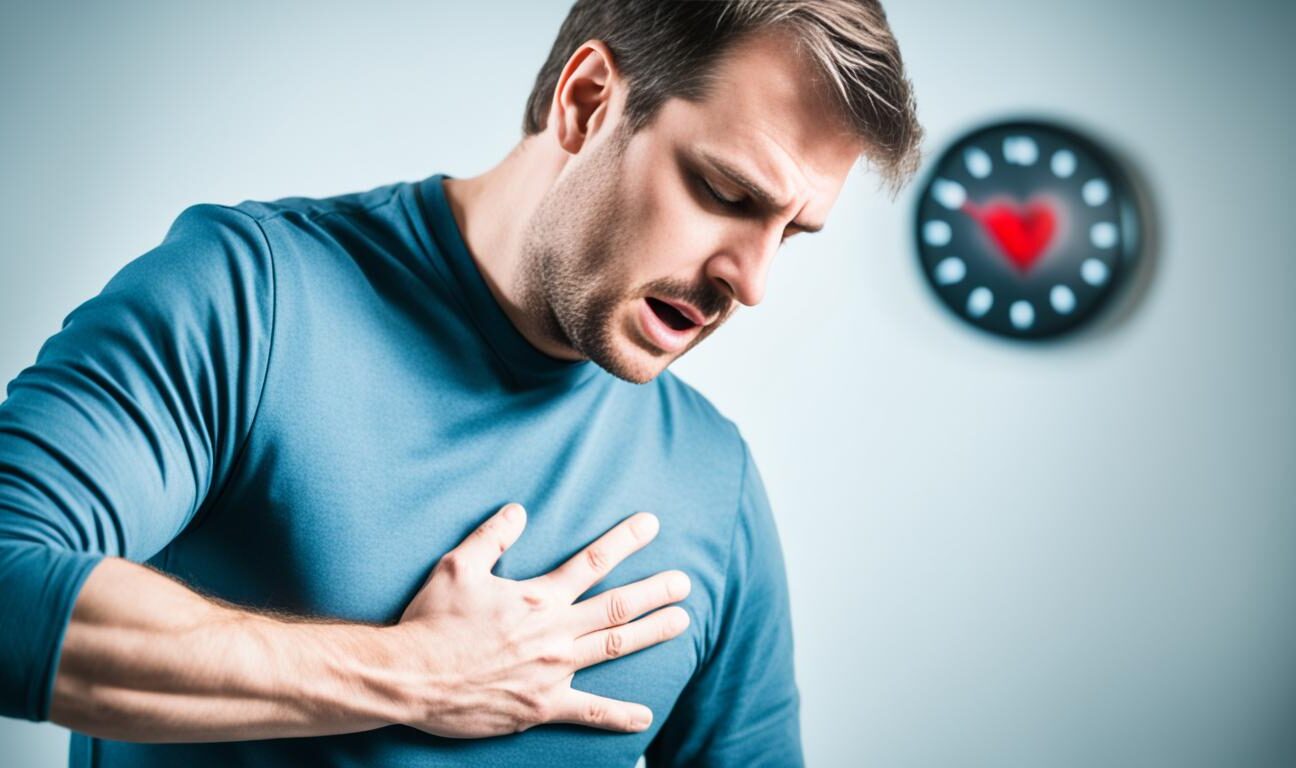

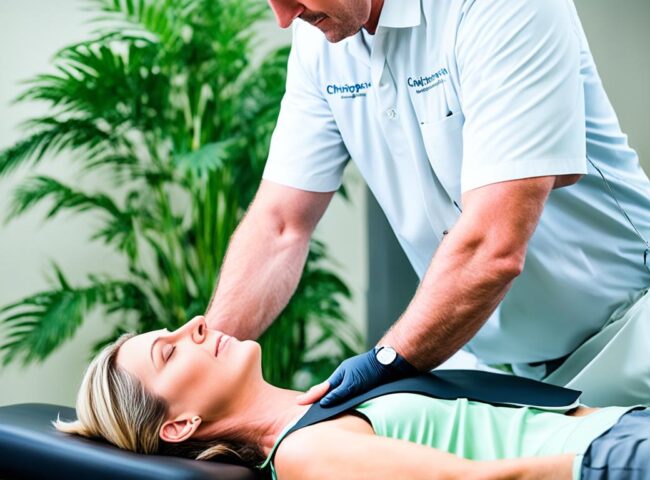



Leave feedback about this